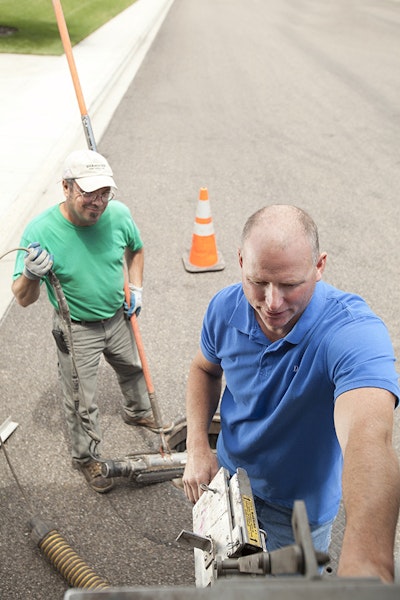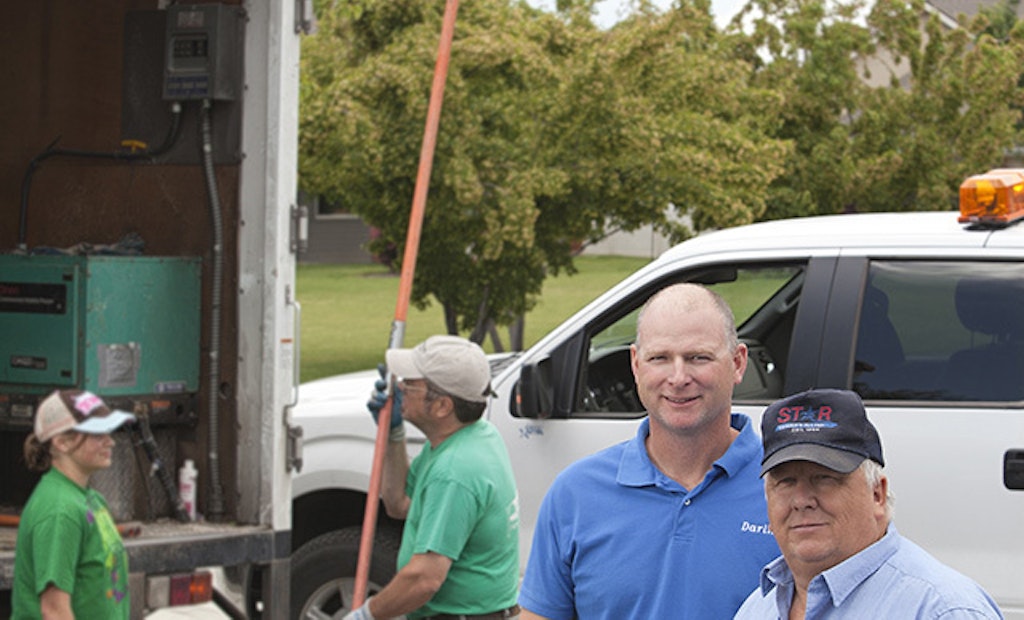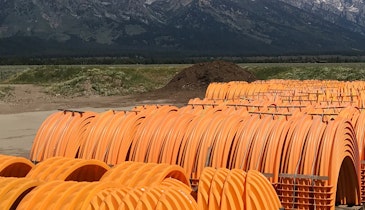Interested in Rehab/Relining?
Get Rehab/Relining articles, news and videos right in your inbox! Sign up now.
Rehab/Relining + Get AlertsHank Day, maintenance and operations foreman of Star Sewer and Water District of Star, Idaho, is on a mission.
"Groundwater infiltrating my system affects my collection system in a variety of ways," Day says. "Biologically, it makes it harder to treat at the plant. Financially, my power cost goes way up through pumping, not only at the plant, but also at the lift stations, not to mention the wear and tear, and higher maintenance costs of servicing the pumps, so we are always looking for new ideas to deal with and remove I&I."
In order to achieve his goals for eliminating I&I, Day and his team of vendors have put together a program of annual cleaning and TV inspection coupled with repairs and rehabilitation performed via trenchless technology. Their progressive and proactive approach has led to significant and tangible financial savings for the sanitary district and serves as a solid model for small communities to improve collection system function and cut costs simultaneously.
Picture postcard landscape
The City of Star lies in a picturesque valley nestled along the Boise River in southwestern Idaho. Star's 5,150 residents enjoy a clean, healthy lifestyle in a rural location that is a popular bedroom community for nearby Boise and Nampa commuters.
The community's sewer and water utilities are the responsibility of the Star Sewer and Water District, an agency independent of the municipality. The sanitary collection system is comprised of 45 miles of sewer line, ranging in size from 8 to 24 inches, of which, 5 miles are old concrete lines. In just 15 years, the community grew from a modest system of 5 miles to 45 miles, adding an additional 900 sewer connections. Although this brought more revenue to the district, the increased demand and customer base also contributed to a rise in inflow and infiltration.
The landscape of the city is an old riverbed containing mainly river rock and sand with very little topsoil. The area is primarily rural farmland and residential property. During the summer months, due to heavy irrigation, Star's groundwater is just 2 feet under the surface in some areas, and many sanitary sewer lines are under water. With the high water table, common issues such as offset joints and cracks result in unwanted groundwater entering their collection system, which puts an extra burden on the treatment plant.
Although the district never conducted a formal I&I study, it was fairly simple for Day and his crews to spot increases as every residence and business in the community is connected to the public utility. By measuring outbound flows from the potable wells and inbound flow to the treatment plant during winter months, Day was able to establish a baseline and determine the best time of year and ways of tracking down sources of I&I.
Study it, find it, repair it
Every year, beginning in March, the district enlists the help of an outside contractor to perform cleaning and CCTV inspection of at least a third of its system. Pipeline Inspection Services of Nampa, Idaho, has been performing the inspection, cleaning and rehabilitation for the district's I&I remediation program for the last five years.
Day generates a series of maps for the areas to be reviewed and improved during the current year's program. Pipeline Inspection Services crews deal with I&I and other maintenance issues they find as they progress through the list of assets to be inspected. Lines are cleaned utilizing a Vactor 2115 combination sewer cleaning unit, and inspected with a vehicle-mounted mainline camera system by CUES. Pipeline Inspection Services streamlines its efforts for the district by having the cleaning and TV crews working in tandem, with just one crew member on each truck. Inspection findings are captured using Granite XP pipe survey software and provided to the district for import into their sewer maintenance database program, Operator Assisted Sewer Information System (OASIS) by Utility Software, for future tracking, analysis and maintenance action.
When defects that could contribute to potential I&I or other system performance problems are discovered, Pipeline Inspection Services develops a plan of action and recommendations for Day. The relationship between contractor and agency is highly symbiotic and the level of cooperation and trust these two entities enjoy has helped the district deal with its infrastructure repairs efficiently and cost-effectively.
"When they come to me and show me the leaks I have in my collection system, they also provide costs and what they feel the best trenchless methods will be to repair the problems. I know when they tell me something they're not blowing smoke, that they're actually telling me the honest truth. They do their homework. I trust them, or else they wouldn't be doing any of my work," Day says.
Diversity and flexibility
Pipeline Inspection Services has brought many trenchless methods to the table for Day's consideration and Day and the district have readily embraced any and all new technology and approaches that can solve the community's infrastructure challenges while saving budget dollars.
To date, the district has employed the use of chemical grouting, manhole-to-manhole CIPP lining, CIPP point repairs and spray-applied polyurethanes, selecting methods and technologies based on each unique situation versus attempting to rehabilitate with a one-size-fits-all approach. Analyzing each repair to determine a best-case scenario not only provides for a solid long-term solution but also gives Day the information needed to allocate his annual budget prudently.
For example, moderate manhole infiltration is most often remediated by high-pressure chemical grouting, using Hydro-Active Cut by
De Neef Construction Chemicals. Chemical grouting is also used in mainline repairs but only in situations where the lines are deep and will retain water, since the grout will not cure properly if conditions are too dry. In those cases, CIP point repairs will be recommended as the better alternative. For manholes, wet wells and lift stations in need of more robust rehabilitation, spray-applied polyurethanes from Sprayroq are applied.
"As a contractor serving small communities like Star, we have to constantly look for new and better ways to address infrastructure problems," says Scott Wendling, vice president of Pipeline Inspection Services. "We evaluate the systems and technology we use and recommend to our clients pretty intensively. We review the key manufacturers in each method and develop an assessment of how they will fit with what our clients need. As a result, we've developed a strong arsenal of solutions to call upon for just about any situation. But we're not afraid to send Hank and other clients in another direction if something we can't provide would be the better fit for their project."
Case in point: a recent dyke washout on the Boise River created a situation where the drainage ditch was several feet deeper than normal and a section of mainline that spanned the drainage canal was completely underwater. Upon inspection, major holes were pinpointed throughout the line. This stretch of line is exposed under normal conditions, so a rehabilitation method that would provide strong structural ability was required. In addition, the line was located on the shoulder of the primary north-south highway route into town, so traffic control and disruption to the community were of concern. CIPP lining was selected as the rehabilitation method and Pipeline Inspection Services performed the installation of a 457-foot-long, 6-millimeter-thick liner, versus a standard 4.5-millimeter-thick liner, to provide the extra structural support needed.
"Without the ability to make such a repair affordably and quickly with trenchless technology, we would've gotten several million gallons a day of extra water coming into the wastewater treatment plant while that line was submerged," Day relates. "Since the repair, we've had zero infiltration coming from that line."
The big pay off
Major repairs like this and countless other small efforts have contributed to the great success of the district's I&I remediation program. During the last season of inspection and repairs, Star Sewer and Water District spent $16,520 on infiltration rehabilitation projects that resulted in a reduction of inflow to the treatment plant by 17 percent. This equated to a lowering of treatment costs by $169 per day or $61,685 annually, netting an overall savings of $45,165 for the year.
"On a national average, 1 gallon per minute of groundwater entering a collection system costs $526.15 per year," Day says. "To some, a figure like $46,000 may seem small, but you take that over a lifetime and that's one heck of a lot of money that you can invest elsewhere to improve your
system, treatment facilities and customer service just from removing a
few gallons of water coming in a day. In the big picture, every drop really does count."








